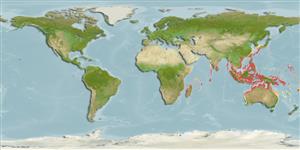Common names from other countries
Environment: milieu / climate zone / depth range / distribution range
Ecologia
marino associati a barriera corallina; distribuzione batimetrica 12 - 25 m (Ref. 90102). Tropical
Indo-West Pacific: Bay of Bengal to Japan and Indonesia.
Size / Peso / Age
Maturity: Lm ? range ? - ? cm
Max length : 26.0 cm TL maschio/sesso non determinato; (Ref. 42740)
Short description
Chiavi di identificazione | Morfologia | Morfometria
Spine dorsali (totale) : 5; Raggi dorsali molli (totale) : 20 - 21; Spine anali: 1; Raggi anali molli: 16 - 17. Body with 3 longitudinal series of large whitish spot, the dark grey-brown interspace a coarse reticulum. A dark grey-brown band from nape to interopercle containing a black ring just above gill opening. A broad dark grey-brown bar below eye. On each side of abdomen with 3 black spots (Ref 42740).
Found solitary or in small groups (Ref. 90102) commonly on deep coastal slopes, from the shallow rocky shore to the deep soft bottom zones (Ref. 48636).
Life cycle and mating behavior
Maturities | Riproduzione | Spawnings | Egg(s) | Fecundities | Larve
Masuda, H., K. Amaoka, C. Araga, T. Uyeno and T. Yoshino, 1984. The fishes of the Japanese Archipelago. Vol. 1. Tokai University Press, Tokyo, Japan. 437 p. (text). (Ref. 559)
IUCN Red List Status (Ref. 130435)
CITES (Ref. 128078)
Not Evaluated
Threat to humans
Harmless
Human uses
Pesca: commerciale; Acquario: Commerciale
Strumenti
Special reports
Download XML
Fonti Internet
Estimates based on models
Preferred temperature (Ref.
115969): 25.5 - 29.3, mean 28.7 (based on 2119 cells).
Phylogenetic diversity index (Ref.
82804): PD
50 = 0.5000 [Uniqueness, from 0.5 = low to 2.0 = high].
Bayesian length-weight: a=0.00692 (0.00311 - 0.01538), b=3.06 (2.88 - 3.24), in cm Total Length, based on LWR estimates for this Genus-body shape (Ref.
93245).
Trophic level (Ref.
69278): 3.6 ±0.4 se; based on size and trophs of closest relatives
Resilienza (Ref.
120179): Medio, tempo minimo di raddoppiamento della popolazione 1.4 - 4.4 anni (Preliminary K or Fecundity.).
Fishing Vulnerability (Ref.
59153): Low vulnerability (16 of 100).
